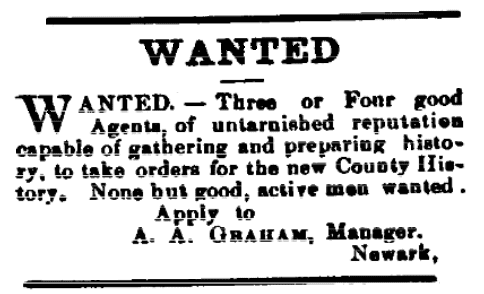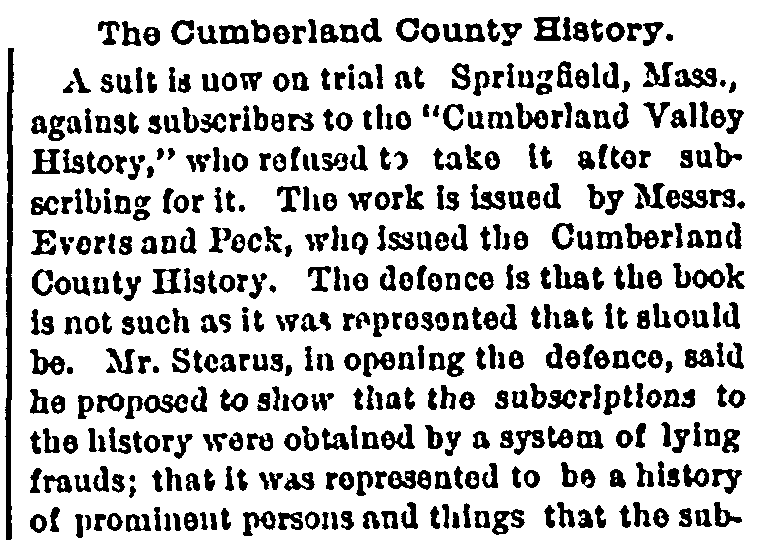Introduction: In this article – part of an ongoing “Introduction to Genealogy” series – Gena Philibert-Ortega writes about a family history source often overlooked by genealogists: local histories, also referred to as county histories or “mug books.” Gena is a genealogist and author of the book “From the Family Kitchen.”
Local histories, also referred to as county histories or “mug books,” can provide much-needed family history clues for genealogists. These books were first published in the 1800s and continue to the present day. Information found in family or individual biographical sketches can include names, relationships, family history, occupational history, migration and more.

Aside from the biographical information they provide, author Val D. Greenwood in his book The Researcher’s Guide to American Genealogy points out that local histories:
“…provide useful information on the settlement patterns of the locality and on the origins of settlers. They tell of religion, economics, education, and social conditions which might affect research procedures and direction. They tell of geography and terrain, water courses, and their effects upon settlement and population.”*
Some People Paid to Be Featured
One of the criticisms of these mug books is that the people featured paid a fee to be prominently covered. While in some cases this was true, it was not true of everyone, since profiles of pioneers long deceased, and unflattering descriptions of some individuals, do exist. In any case, the information in these county histories can be a great help to your family history research.
One way that publishers of these books made money was by pre-selling copies of the work. Salesmen would go door-to-door and collect money from those interested. “Subscribers” were promised a book that not only looked good but included information they would want – like a history of the area, maps, and biographical sketches of prominent citizens.
Not everyone who prepaid for these books was happy with the end result, as reported in this 1880 newspaper article about a lawsuit that was filed against subscribers who refused to take the book because it did not contain pioneers and prominent men as promised – but instead primarily featured men who paid for their inclusion. The article states:
“It was not a history of Western Massachusetts, but only an advertisement of persons who paid to be noticed. It promised detailed maps and there was not one as large as a finger nail.”

Those past accusations serve as an important reminder for today’s researchers. Because the information found in a county history does not include source citations, it should be taken with extreme caution. Use this information only as a starting point; make sure to double check all facts with original documents.
Example: Dauphin County, Pennsylvania, History
This 1893 newspaper article refers to a county history book scheduled to be published in 1896 that was to contain
“…a treasury of biographical sketches and history incident thereto that will be of much value. The work will be introduced with a condensed history of the county, of the course and movements which lead its early settlement; of the experience of the pioneer, in the wilderness; of the introduction of industries, schools and churches; of the development of progress of numerous enterprises and improvement, etc. …The encyclopedia will contain personal sketches of old settlers and prominent and representative citizens of to-day.”

The published work contained not only histories of families, but lists of early settlers and some of their images. You can read the book, Commemorative Biographical Encyclopedia of Dauphin County, Pennsylvania, Containing Sketches of Prominent and Representative Citizens and Many of the Early Scotch-Irish and German Settlers, on the digitized book website Internet Archive.
County Histories as Genealogy Tools
Some things to consider when using a county history:
- Your direct ancestor may not be featured, but look for other relations like a parent or in-law.
- Books were not limited to just a county – some featured several neighboring cities or a region (for example, Western Maryland or Wellfleet and Maywood, Nebraska).
- County histories, like city directories, can provide information about businesses, local governments, and churches.
- Maps and images may be included.
- More than one history of a county may have been published over the span of 100 or more years.
Where to Find Local Histories
Luckily for the modern family historian, local histories can be found online and in libraries. For online copies, look on digitized book websites like Google Books, Internet Archive, and Hathi Trust. FamilySearch’s Family History Books should also be searched, as well as the FamilySearch Catalog. Remember that FamilySearch’s Family History Books includes not only digitized books from the FamilySearch collection, but also partnering repositories.
To find possible copies of a county history in a library, search on WorldCat for the name of the county you are researching. This will assist you in finding copies in libraries worldwide that might be borrowed through interlibrary loan. You can also consult the P. William Filby book, A Bibliography of American County Histories, for a list of titles.
Finally, don’t forget about historical newspapers in your search for county histories, such as those contained in GenealogyBank’s Historical Newspaper Archives. Searching on the name of the county or the phrase “county history” in the newspapers that served that area might reveal plans for publishing such a work, and information that was printed.
———————–
* Greenwood, Val D. The Researcher’s Guide to American Genealogy. 3rd Edition. Baltimore, Maryland: Genealogical Publishing Co. (2013), p. 184.
